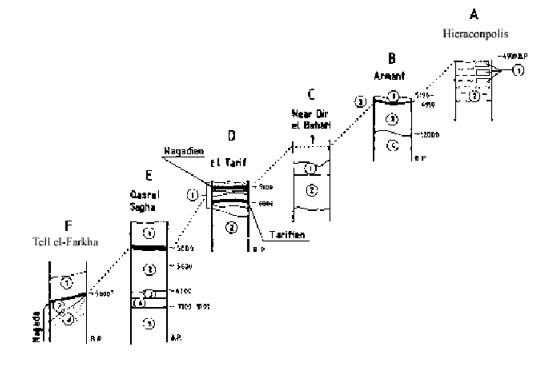Nearly 25 years of geological and mineralogical investigation at various archaeological sites in Egypt gives the opportunity to discuss geological and climatic phenomena observed in sediments which represent the transition from the Neolithic period into the Early Dynastic.
Hierakonpolis
There are no sediments deposited by water at this area which document higher water levels for the Nile during the period between 5200 and 4900 years B.P. The architectural remains discovered were build with the use of dried bricks and are localised at the low floodplain of the Nile (Hofmann, personal communication). This documents a very low level of the Nile and the absence of Nile floods, which would have been able to destroy walls, constructed of dried bricks.
Armant
The geology of site MA 26/86 documents not only the occupation of places localised at the flood zone but also the presence of eolian sediments interfering with Neolithic anthropogenic sediments. This situation suggests a generally dry climate and a very low level of the river. These phenomena due to the absence of floods of Nile are observed between 5190 and 4910 ± 50 y. B.P.
Deir el-Bahari
Most of the sediments representing the transition between Neolithic and Early Dynastic were in this area destroyed by archaeological excavations. Traces of eolian sediments are observed at the zone of transition between the desert and the floodplain.
El-Tarif
The mastabas of El-Tarif are build of dried bricks and localised at the flood zone of the Nile. This localisation confirms that there were no floods of the Nile at the time of the construction of the mastabas. If this would not have been the case, the walls of tombs constructed with dried silt bricks would have been completely destroyed by water. Moreover, sediments filling up the mastabas confirm that during and after their construction climatic conditions were very dry. Proposed dates are around 5100 B.P.
Qasr el-Sagha
Here, the dry climate phase is localised between white silt sands (WSS) and brownish sands (BS), which are dynastic. The proposed date for the dry phase is 5070 ± 110 B.P.
[61]
This sedimentary brake and the presence of human occupation at the flood zone documents a very low level of the Moeris Lake. Moreover, these dry climatic conditions are confirmed by the presence of thin, powder-like eolian sediments covering Neolithic sites. One can add that the effects of dryness are weaker at Qasr el-Sagha than in Upper Egypt.
Tell el-Farkha
The geology of the site documents a low level of Nile at the same time as at the other sites described. This hydrological situation (i.e. a very low Nile) was the reason for the human occupation of a not very high sandy gezira. Up to now there are not C14 dates of this phase but the position of these phenomena are well seen in geological profiles of the site and are localised exactly between the layers of the Nagada culture and of the Dynastic ones.
Conclusions
Geological profiles of sediments in Upper Egypt (Hierakonpolis, Armant, Deir el-Bahari, el- Tarif), profiles of area of Qasr el-Sagha (Fayum region) as well as profiles of Tell el-Farkha (Delta) document a short very dry phase of the climate between about 5200 and 5000 B.C. During this phase the floods of Nile did not exist or were very small and rare. Geological and mineralogical observations are confirmed by human activity (constructions built with the use of dried bricks) at the flood zone of the Nile.
The dry phase endangered the functioning of agriculture and thus the life of the inhabitants of the Nile valley. Most probably these very dry climatic conditions forced people to irrigate their fields. Collective works on irrigation, the construction of canals etc. pushed the Late Neolithic society to a better organisation of irrigation works and as a consequence to a reorganisation of the way of living. The documented climatic phenomena were the most important reasons of social changes leading to the transition from the Neolithic way of living into the much better developed Early Dynastic society.
[62]

A - Hierakonpolis. 1- wall of temple build of dried
bricks, 2- grey silt of Nile (not divided)
B - Armant-Site 23/86. 1- eolian and stream sediments, 2- archaeological
layers, 3- pediment, 4- Sahaba Formation (grey silts)
C - Deir el Bahari. Youngest eolian sediments destroyed. 1- pediment,
2- Sahaba Formation (reddish silts)
D - el-Tarif. 1- complex of eolian sediments containing archaeological
layers
E - Qasr el-Sagha. 1- brownish sands (dynastic), sedimentary break
in the presence of archaeological layers, 2- complex of white silty sands,
3- grey silts, 4- grey diatomites, 5-diatomites.
F - Tell el Farkha. 1- brownish silts (dynastic), 2- grey Nile
silts, 3- Pleistocene gezira sand.
[63]